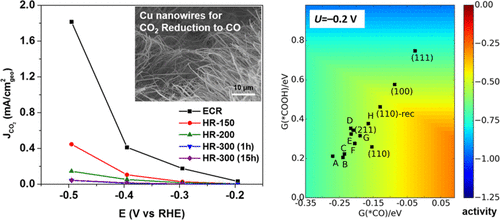当前位置:
X-MOL 学术
›
ACS Catal.
›
论文详情
Our official English website, www.x-mol.net, welcomes your
feedback! (Note: you will need to create a separate account there.)
Mechanistic Insights for Low-Overpotential Electroreduction of CO2 to CO on Copper Nanowires
ACS Catalysis ( IF 11.3 ) Pub Date : 2017-11-17 00:00:00 , DOI: 10.1021/acscatal.7b03107 Liang Cao 1 , David Raciti 1 , Chenyang Li 1 , Kenneth J. T. Livi 1 , Paul F. Rottmann 1 , Kevin J. Hemker 1 , Tim Mueller 1 , Chao Wang 1
ACS Catalysis ( IF 11.3 ) Pub Date : 2017-11-17 00:00:00 , DOI: 10.1021/acscatal.7b03107 Liang Cao 1 , David Raciti 1 , Chenyang Li 1 , Kenneth J. T. Livi 1 , Paul F. Rottmann 1 , Kevin J. Hemker 1 , Tim Mueller 1 , Chao Wang 1
Affiliation

|
Recent developments of copper (Cu)-based nanomaterials have enabled the electroreduction of CO2 at low overpotentials. The mechanism of low-overpotential CO2 reduction on these nanocatalysts, however, largely remains elusive. We report here a systematic investigation of CO2 reduction on highly dense Cu nanowires, with the focus placed on understanding the surface structure effects on the formation of *CO (* denotes an adsorption site on the catalyst surface) and the evolution of gas-phase CO product (CO(g)) at low overpotentials (more positive than −0.5 V). Cu nanowires of distinct nanocrystalline and surface structures are studied comparatively to build up the structure–property relationships, which are further interpreted by performing density functional theory (DFT) calculations of the reaction pathway on the various facets of Cu. A kinetic model reveals competition between CO(g) evolution and *CO poisoning depending on the electrode potential and surface structures. Open and metastable facets such as (110) and reconstructed (110) are found to be likely the active sites for the electroreduction of CO2 to CO at the low overpotentials.
中文翻译:

在铜纳米线上将CO 2低电势还原为CO的机理研究。
铜(Cu)基纳米材料的最新发展已使CO 2在低过电势下发生电还原。然而,在这些纳米催化剂上低过剩CO 2还原的机理仍然难以捉摸。我们在这里报告对CO 2的系统研究还原高密度铜纳米线,重点是了解表面结构对* CO形成的影响(*表示催化剂表面的吸附位置)和气相CO产物(CO(g))的释放低过电位(高于-0.5 V的正电压)。对具有不同纳米晶体和表面结构的Cu纳米线进行了比较研究,以建立结构与性质之间的关系,通过在Cu的各个面上执行反应路径的密度泛函理论(DFT)计算,可以进一步解释这种关系。动力学模型揭示了取决于电极电势和表面结构的CO(g)释放与* CO中毒之间的竞争。发现诸如(110)和重建的(110)之类的开放且亚稳态的小面很可能是CO电还原的活性位点在低超电势下,CO的浓度为2。
更新日期:2017-11-19
中文翻译:

在铜纳米线上将CO 2低电势还原为CO的机理研究。
铜(Cu)基纳米材料的最新发展已使CO 2在低过电势下发生电还原。然而,在这些纳米催化剂上低过剩CO 2还原的机理仍然难以捉摸。我们在这里报告对CO 2的系统研究还原高密度铜纳米线,重点是了解表面结构对* CO形成的影响(*表示催化剂表面的吸附位置)和气相CO产物(CO(g))的释放低过电位(高于-0.5 V的正电压)。对具有不同纳米晶体和表面结构的Cu纳米线进行了比较研究,以建立结构与性质之间的关系,通过在Cu的各个面上执行反应路径的密度泛函理论(DFT)计算,可以进一步解释这种关系。动力学模型揭示了取决于电极电势和表面结构的CO(g)释放与* CO中毒之间的竞争。发现诸如(110)和重建的(110)之类的开放且亚稳态的小面很可能是CO电还原的活性位点在低超电势下,CO的浓度为2。











































 京公网安备 11010802027423号
京公网安备 11010802027423号